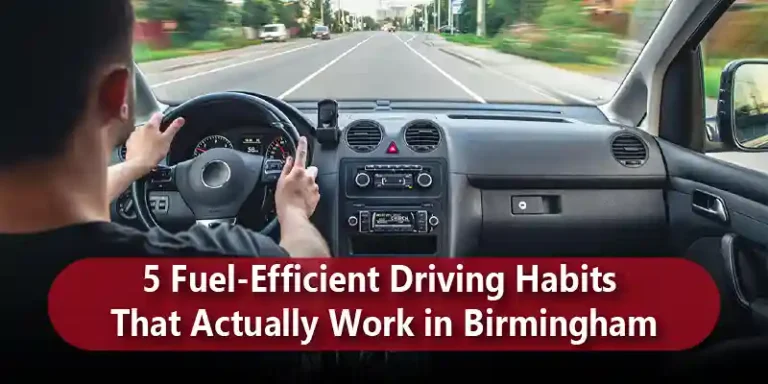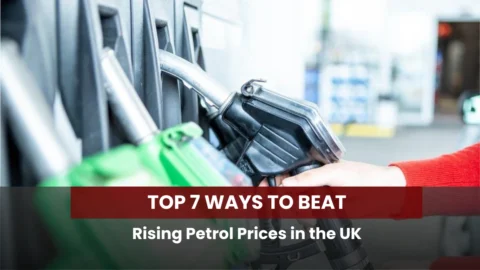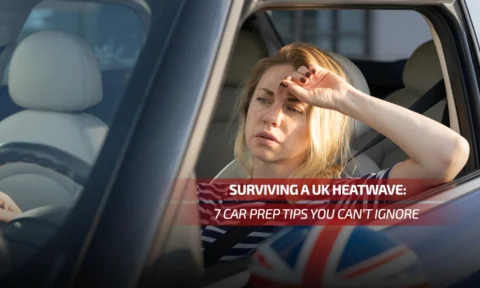Birmingham—the heart of the UK’s road network. A vibrant, bustling, and ever-expanding city, its sheer size and complex infrastructure, from the spaghetti junction to the inner-city ring road, mean that driving here is a unique challenge. And a costly one.
According to various reports, drivers in the wider Birmingham area can spend a staggering amount of time stuck in traffic, a factor that directly translates into wasted fuel and money. Stop-start driving, idling at red lights, and aggressive acceleration on motorway on-ramps are all fuel-guzzling behaviours that empty your wallet faster than you might think. For the average driver, mastering fuel-efficient driving isn’t just a green initiative; it’s a critical personal finance strategy.
You don’t need a new hybrid or an electric car to make a difference. By adopting a few key fuel-efficient driving habits, you can dramatically reduce your consumption, cut down on your costs, and even lower your stress levels while navigating the West Midlands. This comprehensive guide details the five most effective, proven fuel saving driving tips tailored specifically for the Birmingham environment, showing you how to save fuel when driving every single day.
Understanding the Birmingham Challenge: Why Fuel-Efficient Driving Matters Here
Birmingham’s road network, defined by its motorways, its inner-city ring road, and the now-active Clean Air Zone (CAZ), presents a unique driving environment. High traffic volume, frequent roadworks, and the inherent ‘stop-start’ nature of city driving all conspire against good fuel economy.
The Hidden Cost of City Congestion
When you’re sat idling on the Aston Expressway or inching through the city centre, your car is still burning fuel—up to two litres per hour, according to some estimates. This wasted fuel quickly adds up. Furthermore, the constant need to brake and then accelerate again is where most fuel is wasted. Aggressive acceleration requires significantly more fuel than a smooth, gradual increase in speed.
This is precisely why adopting economical driving techniques UK is so vital for Brummie drivers. It’s about adapting your driving style to counteract the specific, fuel-draining conditions of a congested urban landscape.
The Top 5 Fuel-Efficient Driving Habits for Birmingham Drivers
The secret to better MPG isn’t complicated; it’s about anticipating traffic, being gentle with your controls, and ensuring your car is in optimal condition. Here are the five habits that yield the biggest, most tangible results.
1. Master the ‘Smooth Pedal’ Technique: Gentle Acceleration and Braking
This is, arguably, the single most powerful fuel-efficient driving habit you can adopt, particularly in the stop-start nature of Birmingham traffic.
Accelerate like a Professional: Ease onto the accelerator. Aim for gradual, smooth acceleration. When pulling away from lights on routes like the A38 or the ring road, resist the urge to ‘floor it.’ This simple change drastically reduces the demand for fuel.
Anticipate to Coast: This ties directly into the next habit, but when you see a red light, a roundabout, or slowing traffic ahead (common on the M6/M5 junction), lift your foot off the accelerator early and coast in gear. A modern car’s Engine Control Unit (ECU) will often cut the fuel supply completely while in gear and decelerating, effectively giving you ‘free’ distance.
Practical Birmingham Tip: When joining the main flow of traffic from a slip road, accelerate smoothly but firmly to match the speed, and then immediately back off the pedal to maintain speed.
2. Look Ahead: The Power of Anticipation and Maintaining Momentum
Fuel-efficient driving is often called ‘Eco-Driving,’ but a better term is ‘Defensive Driving for Fuel Saving.’ This habit is all about seeing the road like a chess game, not a sprint.
When the car ahead brakes, you can often simply lift off the accelerator and let your car slow down naturally, coasting rather than having to hit the brakes. This preserves your momentum, a key component of how to save fuel when driving.
Anticipate Traffic Lights: On long stretches like the Hagley Road or Tyburn Road, learn the traffic light patterns. If you see the light ahead is red, ease off the gas much earlier. This allows you to potentially coast right up to the line or, better yet, time it perfectly so the light turns green just as you arrive, avoiding a full stop and the massive fuel cost of starting from zero.
3. Shift Up Early: Optimising Your Gear Changes
For drivers with a manual gearbox, mastering the ‘early upshift’ is one of the most effective economical driving techniques UK has advocated for decades.
The Rule of Thumb: For most modern petrol cars, aim to change up a gear when the engine reaches around 2,500 rpm. For diesel vehicles, this figure is often lower, around 2,000 rpm.
Drive in the Highest Gear Possible: Once you’ve reached your desired cruising speed (even 30mph in the city), ensure you are in the highest gear your car can comfortably manage without feeling strained. Cruising in third gear at 30mph will use more fuel than cruising in fifth gear at the same speed. This simple change is a powerful fuel-saving driving tip.
Bonus Tip for Automatics: Many modern automatic cars in the UK now have an ‘Eco’ mode. Use it! This mode often adjusts the transmission’s shift points to automatically favour lower revs, executing the principle of shifting up early for you.
4. Ruthlessly Eliminate Unnecessary Weight and Drag
The engine has to work harder and thus burn more fuel to move a heavier or less aerodynamic car.
The Boot Detox: Every extra kilogram of weight means more fuel is needed to accelerate it. Clear out your boot of anything that is not essential for your journey. Those old bags of sand, unused pushchairs, or emergency winter kits can wait in the garage until needed.
Remove Roof Attachments: A common sight in the UK, especially after summer holidays, is empty roof boxes or bike racks left on the car. These accessories massively increase wind resistance drag, which can spike your fuel consumption by up to 20% at motorway speeds on the M6. If it’s not being used, take it off. This is a critical yet often overlooked step in effective fuel-efficient driving.
5. Be a Stickler for Tyre Pressure and Maintenance
This habit is less about driving style and more about vehicle health, but its impact on fuel efficiency is undeniable and universally applicable.
Check Tyre Pressure Monthly: Ensure your tyres are inflated to the manufacturer’s recommended pressure. This figure can usually be found inside the driver’s side door jamb, in the fuel filler cap, or in your vehicle’s manual. Correct tyre pressure is a non-negotiable fuel-saving driving tip that also improves safety and tyre lifespan.
Regular Servicing: A well-maintained engine runs more efficiently. Ensure you stick to your vehicle’s service schedule. Fresh oil, clean air filters, and properly tuned spark plugs all contribute to maximum fuel-efficient driving performance.
Most Common Questions
This depends on your speed. At low city speeds, opening the windows is generally more fuel-efficient than running the air conditioner, which puts a significant load on the engine. However, at motorway speeds, the aerodynamic drag created by open windows is greater than the fuel penalty of the air-con. Therefore, use windows in the city and air conditioning sparingly on the motorway.
Idling in traffic consumes a surprising amount of fuel, up to two litres per hour in some large engine vehicles, though less for modern small-engine cars. If you are going to be stationary for more than about 60 seconds, it is more fuel-efficient to switch off your engine. Modern systems do this automatically, using one of the best economical driving techniques UK technology has to offer.
The CAZ charge is based on your vehicle’s emissions standard, not your driving habits. However, the CAZ covers a highly congested area of central Birmingham. Since congestion is the enemy of fuel-efficient driving, the best CAZ-related fuel-saving driving tip is to plan your route to avoid the most congested times and roads within the zone, if possible, even if your vehicle is compliant.
For modern, fuel-injected cars, it is almost always more fuel-efficient to coast in gear. When you take your foot off the accelerator while the car is in gear, the fuel cut-off system activates, sending virtually zero fuel to the engine. If you switch to neutral, the engine needs a small amount of fuel to stay idling. Staying in gear also gives you better control for safe, economical driving techniques UK.
Generally, no. For most standard, non-performance vehicles, using premium fuel higher octane offers no noticeable increase in fuel economy or performance. Stick to the fuel type recommended by your manufacturer to ensure the best fuel-efficient driving and to avoid paying extra for a negligible difference in MPG. Join the Ask About Cars community where drivers share tips, hacks, and real solutions for everyday car care and long-term performance.







